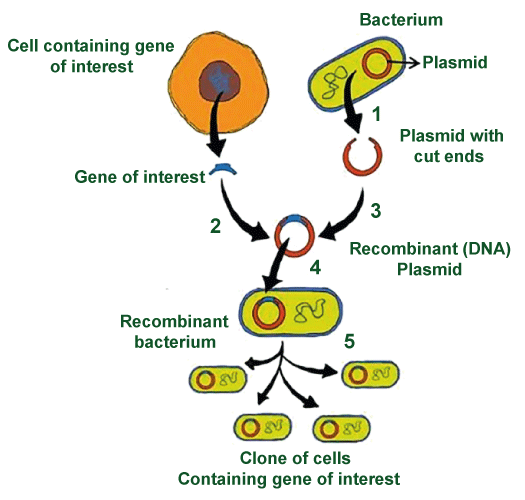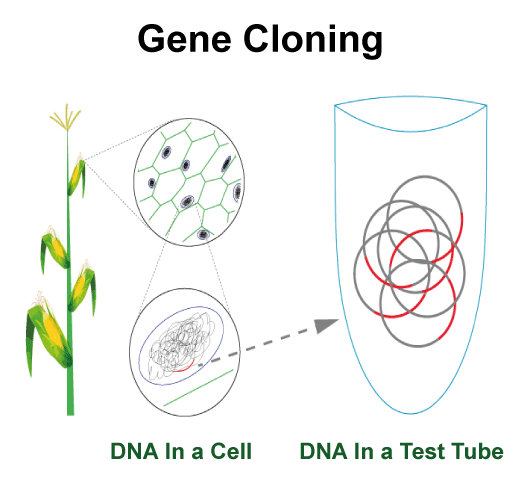Gene CloningGene cloning is a technique used in genetic engineering to create copies of specific genes or DNA sequences. It allows scientists to isolate and amplify genes for research purposes, drug development, and improving crop yields. Gene cloning is a procedure that permits researchers to copy and focus on one specific gene rather than dealing with the entire genome. It has become an indispensable tool in modern biotechnology because it produces similar copies of genes. Cloning is a method of isolating and amplifying genes by cutting out desired sections from DNA using restriction enzymes and inserting them into another piece called a vector through a ligation reaction. The technique known as gene cloning, DNA cloning, molecular cloning or recombinant DNA technology all refer to the same thing and are used interchangeably by scientists depending on their preferences or fields of study. This article demonstrates gene cloning and its significant details. Gene Cloning Requirements (Cell-Based)
Principles and Steps in Gene CloningTo clone a gene, it is inserted into a vector which acts as a vehicle to transport the gene into a host cell where the vector multiplies and creates similar copies of itself and the gene. Bacteria are commonly utilised as host cells for cloning, however other living cells can also be utilised. During cell division, recombinant DNA molecules are passed down and replicated in the host cells. After numerous divisions, a clone of identical cells is produced with one or more copies of the recombinant DNA molecule, resulting in gene cloning. Steps Involved in Gene Cloning
There are seven significant steps in gene cloning which are as follows. 1. Isolate DNA Fragments for Cloning
2. The Process of Creating Recombinant DNA by Inserting isolated DNA into a Vector
3. Introducing Recombinant DNA into an Organism known as the Host Cloning vectors are carrier DNA molecules with common features.
4. The Process of Selecting transformed Host Cells and Identifying the Clone that contains a Specific Gene
5. The Expression of a Gene in a Host Organism via Multiplication The recombinant vector is mostly transformed into a suitable host cell, usually a bacterial cell. This is done for the following reasons:
6. Isolation of Multiple Gene Copies/Proteins
7. Purification of Genes/Protein
Gene Cloning Applications
1. Gene Function: Gene function is a crucial aspect of DNA and gene analysis. Cloning genes allow for the determination of their existence or non-existence. The recombinant plasmid can be used to establish the purpose of a gene, as well as for gene knockout, knockdown and transgene creation. PCR is an effective, quick and economical technique that has replaced conventional methods for cloning genes by increasing or synthesizing them with Taq DNA polymerase. 2. Gene Structure: Cloning can be utilized to identify and sequence the structure of a particular gene, allowing for analysis of variations in its sequence. 3. Constructing Genetically Modified Organisms: Gene cloning is a popular technique for constructing genetically modified organisms through recombinant DNA. It involves inserting a transgene into plants, bacteria or mice to modify their characteristics and phenotypes, as well as create disease-related models. 4. Gene Therapy: Gene therapy uses gene cloning to replace or repair damaged DNA sequences or genes with healthy versions, providing a potential treatment option for genetic diseases. 5. Mutational Studies: The polymerase chain reaction technique has replaced gene cloning for mutational studies and identification, as it is faster and cheaper. It can also be used for site-directed mutagenesis research. The isolation and analysis of genes can reveal their nucleotide sequence, control sequences, and functional properties. This information enables the identification of mutations related to diseases and the engineering of organisms for specific purposes, such as insulin production or insect resistance. 6. Biopharmaceuticals: Gene cloning is utilized for the creation of synthetic as well as recombinant proteins, including insulin and growth factors. This procedure is considered innovative in the biopharmaceuticals field. Gene Cloning LimitationsIn the 80s, DNA cloning was a significant discovery, but it has limitations and drawbacks.
ConclusionGene cloning is a process of making copies of DNA, but it has limitations. The discovery of the Polymerase chain reaction in 1983 overcame these limitations and provided a rapid, cost-effective, accurate and high-yield technique for gene cloning. PCR is a powerful tool in genetics and genomics as it saves time, and money and provides ease in experiments by producing more DNA copies than conventional gene cloning techniques. FAQs1. What is the Main Purpose of Gene Cloning? Cloning is the process of replicating DNA to produce identical copies of specific genes from cells of other organisms. This technology helps researchers study how genes influence characteristics and grow large quantities of genetically modified crops that resist pests. 2. What is the role of DNA Ligases in Gene Cloning? DNA ligases are crucial for gene cloning as they facilitate the bonding of DNA strands during cell division through a process known as ligation. 3. Why use PCR before Gene Cloning in Cells? PCR is a technique used to amplify DNA templates for analysis by copying large amounts of DNA from one sample into another through repeated cycles of heating and cooling at specific temperatures.
Next TopicGenes Meaning
|
 For Videos Join Our Youtube Channel: Join Now
For Videos Join Our Youtube Channel: Join Now
Feedback
- Send your Feedback to [email protected]
Help Others, Please Share









